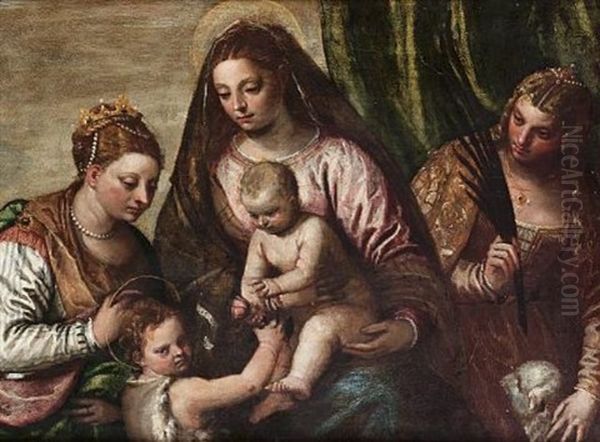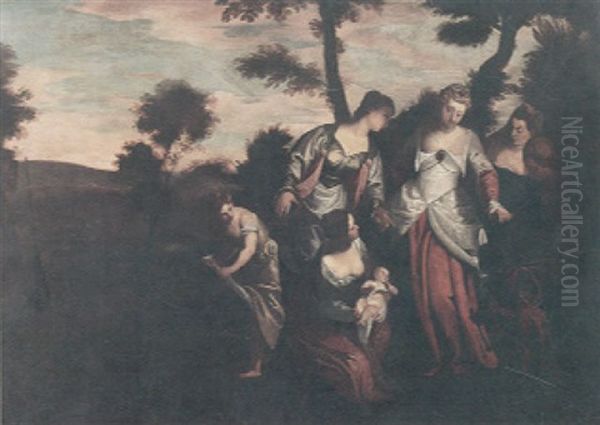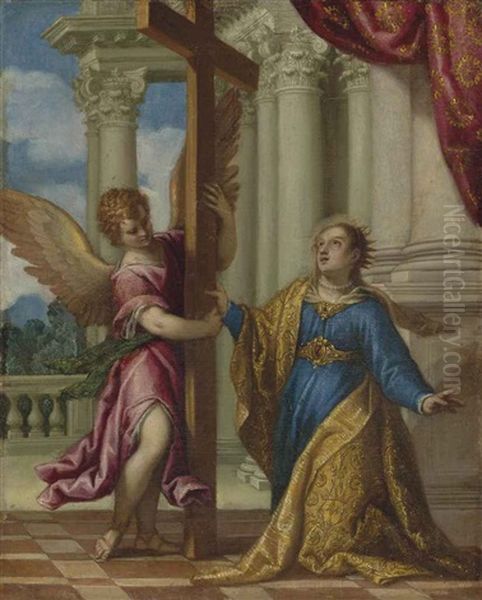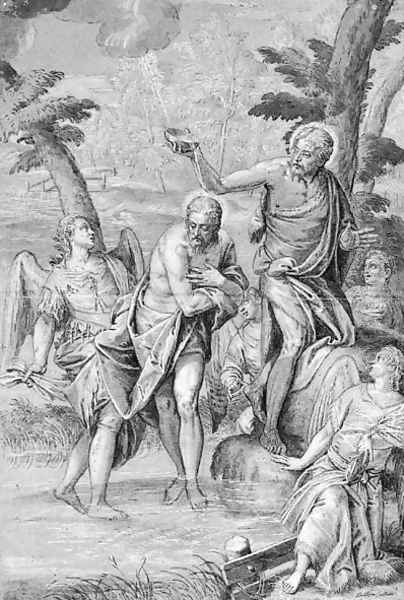The annals of Venetian art are replete with towering figures whose luminous works defined an era of unparalleled creativity and opulence. Among these, the name Paolo Veronese resonates with grandeur, his vast canvases celebrated for their vibrant color, dynamic compositions, and theatrical flair. Yet, within the bustling activity of his renowned workshop, another talent, his youngest son Carlo Caliari, more affectionately known as Carletto, was honing his skills. Though his life was tragically short, Carletto Caliari carved out a distinct artistic identity, contributing significantly to the late Renaissance Venetian school with a style marked by exquisite delicacy and a keen observational eye. This exploration delves into the life, work, and legacy of Carletto Caliari, a painter whose contributions, while sometimes overshadowed by his father's colossal reputation, merit closer examination for their intrinsic quality and their reflection of the evolving artistic currents of late 16th-century Venice.
The Caliari Lineage and Carletto's Emergence
Carlo Caliari, or Carletto, was born into an environment steeped in artistic fervor. The precise year of his birth is cited variously as 1567, 1569, or 1570, in Venice, a city then at the zenith of its cultural and mercantile power. He was the youngest son of the celebrated Paolo Caliari, universally known as Paolo Veronese, a titan of the Venetian High Renaissance, and Antonia Caliari, who hailed from a noble family. This familial connection was pivotal, as Carletto, alongside his elder brothers Benedetto Caliari (himself a painter) and Gabriele Caliari (more of a studio manager), was immersed in the world of painting from his earliest years.

The Veronese workshop was not merely a place of production but a vibrant center of artistic learning and collaboration. It was here that Carletto received his foundational training, directly under the tutelage of his illustrious father. He would have learned the intricate processes of painting, from grinding pigments and preparing canvases to mastering the principles of drawing (disegno) and the Venetian emphasis on color (colorito). The workshop was a hive of activity, fulfilling prestigious commissions for churches, confraternities, and private patrons, exposing young Carletto to a wide array of subjects, scales, and artistic challenges. This upbringing ensured a deep understanding of the Veronese style, characterized by its luminous palettes, complex figural arrangements, and a sense of joyous, almost theatrical, magnificence.
The "Haeredes Pauli" and Workshop Collaboration
The death of Paolo Veronese in April 1588 marked a significant turning point for the Caliari family and their workshop. Paolo left behind numerous unfinished commissions and a formidable artistic legacy. It fell to his sons, primarily Benedetto and Carletto as active painters, with Gabriele handling administrative aspects, to continue the workshop's operations. They adopted the collective signature "Haeredes Pauli Caliarii Veronensis" (Heirs of Paolo Caliari of Verona) or variations thereof, such as "Heredes Pauli," signifying their commitment to upholding their father's artistic standards and completing his outstanding projects.
This collaborative phase was crucial. It allowed for the seamless continuation of the workshop's output, ensuring that patrons' expectations were met. Carletto played an active role in these endeavors, often contributing his refined touch to specific passages or figures within larger compositions initiated by his father or managed by Benedetto. Art historians have painstakingly worked to discern the individual hands within these collaborative pieces, a complex task given the shared stylistic vocabulary cultivated within the Veronese studio. However, Carletto's emerging preference for more delicate modeling and intimate characterization began to distinguish his contributions. This period also provided him with invaluable experience in managing large-scale projects and adapting his skills to diverse artistic demands, further shaping his development as an independent artist.
Carletto's Distinctive Artistic Voice
While deeply rooted in the Veronese tradition, Carletto Caliari developed a personal style that, though sharing its luminous palette, diverged in sensibility. His father's art often celebrated grand, populous scenes filled with robust, idealized figures. Carletto, by contrast, demonstrated a penchant for a more refined, delicate, and often more intimate mode of expression. His figures, while elegant, could possess a slender grace and a more nuanced psychological depth. He excelled in the rendering of details – the subtle play of light on fabric, the intricate patterns of ornamentation, and the expressive rendering of faces, particularly heads.

A significant aspect of Carletto's artistry was his skill as a draftsman. He became particularly adept at creating head studies using colored chalks – often black, red, and white – on blue or buff-colored paper. This technique, which he reportedly learned from or was influenced by the Bassano family of painters, particularly Francesco Bassano the Younger, allowed for a remarkable vivacity and immediacy. These drawings, often preparatory studies for larger paintings, stand as accomplished works in their own right, showcasing his ability to capture individual character and subtle gradations of light and shadow with remarkable sensitivity. His line was often more dynamic and his modeling softer than the more sculptural approach sometimes seen in his father's preparatory drawings.
Carlo Ridolfi, a 17th-century biographer of Venetian artists, praised Carletto's talent, noting his promising abilities and suggesting that had he lived longer, he might have even surpassed his father's achievements in certain respects. This contemporary assessment highlights the recognition Carletto received for his individual skill, even while working within the formidable shadow of Paolo Veronese.
Representative Works and Thematic Focus
Carletto Caliari's oeuvre, though curtailed by his early death, includes a range of religious paintings, altarpieces, and portraits that exemplify his distinct style. Many of these were commissions for Venetian churches, continuing the family's strong ties to ecclesiastical patronage.
One notable work is the Madonna and Saints (also referred to as Madonna in Glory with Saints), located in the refectory of the Church of San Sebastiano in Venice – a church famously decorated by his father. Though perhaps smaller in scale than some of Veronese's grand machines, this painting demonstrates Carletto's command of composition and his ability to imbue figures with a gentle piety.
The Annunciation, an altarpiece for the church in Ghiera (or possibly the Chiesa dei Gesuati, Santa Maria del Rosario, in Venice, depending on sources), is another significant example of his religious work. Such themes, central to Counter-Reformation spirituality, were common, and Carletto approached them with a characteristic sensitivity, focusing on the emotional and spiritual import of the narrative.
His contributions to the Church of San Giorgio Maggiore in Venice include an altarpiece depicting the Madonna and Child and another featuring the Adoration of the Magi. These works, situated in a prominent Palladian church, would have been highly visible and attest to the continued demand for the Caliari workshop's output. The Adoration of the Magi, in particular, would have offered Carletto ample opportunity to display his skill in rendering rich textiles, exotic figures, and intricate details, all hallmarks of the Venetian tradition.

Beyond these larger altarpieces, Carletto's skill in capturing individual likenesses and character is evident in works like the Portrait of a Bearded Man. This drawing, often executed in his favored medium of chalks on tinted paper, showcases his ability to convey personality and presence with an economy of means and a remarkable sensitivity to form and texture. Such studies reveal an artist deeply engaged with the human face and its expressive potential.
Another work attributed to him, Saint Augustine Dictating the Rule of his Order, further illustrates his capacity for narrative clarity and refined execution within a religious context. The depiction of the saint, engrossed in his scholarly and spiritual task, would have resonated with the intellectual and devotional currents of the time.
Challenges in Attribution and Artistic Identity
The collaborative nature of Renaissance workshops, especially one as prolific as Veronese's, inherently presents challenges for art historians in definitively attributing works to individual hands. After Paolo Veronese's death, the "Haeredes Pauli" system, while ensuring the workshop's continuity, further complicates the precise identification of Carletto's specific contributions to larger projects. Scholars have often relied on stylistic analysis, focusing on passages that exhibit Carletto's characteristic delicacy, his particular way of rendering faces, or his more dynamic figural poses, to distinguish his work from that of his brother Benedetto or from the established manner of their father.
There are instances where works have been misattributed. For example, a piece initially thought to be by Jacopo Bassano, a leading figure of another prominent Venetian artistic family, was later correctly identified as a work by Carletto. Such reattributions underscore the ongoing scholarly process of refining our understanding of his oeuvre. Some head studies, while clearly by Carletto, have sparked debate as to whether they were preparatory sketches for his own independent compositions or for figures within larger collaborative paintings undertaken by the family workshop.
Despite these complexities, a core body of work is now generally accepted as Carletto's, revealing an artist who, while honoring his father's legacy, was forging his own path. His style, sometimes described as more slender or more animated than Paolo's, suggests an artist responsive to the evolving tastes of the late 16th century, which were beginning to move towards the dynamism that would characterize the early Baroque.
Carletto in the Broader Context of Venetian Painting

Carletto Caliari operated within one of the richest artistic environments in European history. Venice in the 16th century was a crucible of innovation, particularly in the use of color and light. The towering figures of the Venetian Renaissance – Giovanni Bellini, who laid the foundations for its coloristic tradition; Giorgione, with his enigmatic and atmospheric paintings; Titian (Tiziano Vecellio), whose mastery of color, composition, and psychological portraiture set an international standard; Tintoretto (Jacopo Robusti), known for his dramatic lighting, dynamic compositions, and spiritual intensity; and, of course, Paolo Veronese himself – had collectively established Venice as a preeminent center of art.
Carletto inherited this magnificent tradition. His work, like that of his father, is firmly rooted in the Venetian emphasis on colorito – the belief that color is paramount in achieving lifelike and emotionally resonant effects. However, the artistic landscape was not static. By the time Carletto was active, the High Renaissance was transitioning. The influence of Mannerism, with its elongated figures, complex poses, and heightened emotionalism, had been felt in Venice, though often tempered by the city's inherent naturalism and love of sensuous surfaces.
Carletto's contemporaries included figures like Jacopo Palma il Giovane, who became a dominant force in Venetian painting after the passing of Titian, Tintoretto, and Veronese. Palma il Giovane's style, like Carletto's, built upon the achievements of the older generation but also incorporated a more fluid brushwork and dramatic intensity that prefigured the Baroque. The Bassano family – Jacopo Bassano and his sons, including Francesco and Leandro Bassano – were also highly influential, particularly known for their genre scenes, nocturnal effects, and a more rustic, yet still vibrant, naturalism. Carletto's adoption of their chalk drawing technique on colored paper speaks to the cross-currents of influence among Venetian artists.
While Paolo Veronese, Titian, and Tintoretto are often considered the great triumvirate of the Venetian High Renaissance, Carletto belonged to the subsequent generation tasked with carrying this legacy forward. His work can be seen as a bridge, maintaining the opulent color and compositional richness of his father's generation while subtly infusing it with a more delicate, perhaps more introspective, sensibility. Other painters active in or influencing Venice during the broader Cinquecento, such as Paris Bordone, with his rich colors and often sensual mythologies, or Andrea Schiavone, whose painterly freedom influenced even Veronese, contributed to the diverse artistic tapestry Carletto inherited. Even earlier figures like Lorenzo Lotto, with his unique psychological acuity and slightly eccentric compositions, demonstrate the breadth of Venetian artistic exploration. While Albrecht Dürer, a German master, had visited Venice earlier in the century and absorbed Venetian color, his primary impact was more on Northern European art, though his graphic work was widely known and respected across Europe.
A Promising Career Cut Short
The most poignant aspect of Carletto Caliari's story is its brevity. He died in Venice, likely between 1592 and 1596, though some sources suggest the earlier date. This means his independent artistic career, following his father's death in 1588, spanned less than a decade, and he was likely only in his early to mid-twenties when he passed away. This premature end inevitably leads to speculation about what he might have achieved had he lived longer.
The refinement and sensitivity already evident in his work suggest a trajectory towards a highly personal and accomplished style. Ridolfi's assertion that he showed the potential to rival his father is a testament to the high regard in which his talents were held. His early death was not only a personal tragedy for the Caliari family but also a loss for Venetian art, depriving it of a voice that was just beginning to assert its unique qualities. The Caliari workshop continued under Benedetto and Gabriele for some time, but the particular spark of Carletto's talent was extinguished.
Legacy and Conclusion
Carletto Caliari remains a figure of interest for several reasons. Firstly, he provides a fascinating case study of artistic inheritance and individuality within a dominant family workshop. He successfully navigated the challenge of working under a famous father, absorbing his lessons while subtly forging his own stylistic preferences. Secondly, his works, particularly his drawings, are admired for their intrinsic beauty, their delicate execution, and their sensitive portrayal of human character. They reveal a skilled hand and a thoughtful artistic mind.
His paintings, though fewer in number than those of longer-lived contemporaries, contribute to the rich tapestry of late 16th-century Venetian art. They demonstrate the enduring vitality of the Veronese tradition while also hinting at the stylistic shifts that were beginning to take place. Carletto's emphasis on refined detail, graceful figures, and a certain gentle expressiveness offers a counterpoint to the more heroic and grandiose manner often associated with his father.
In the grand narrative of art history, Carletto Caliari might be seen as a secondary figure, his light somewhat dimmed by the brilliance of Paolo Veronese. However, a closer look reveals an artist of considerable talent and promise. He was a gifted draftsman, a sensitive colorist, and a painter who, in his brief career, made a distinctive contribution to the Venetian school. His legacy is a reminder that even within the most celebrated artistic dynasties, individual talents can flourish, and that a life cut short can still leave behind a body of work worthy of admiration and study. Carletto Caliari, the "little Charles," was indeed a precious, if fleeting, jewel in the crown of Venetian painting.